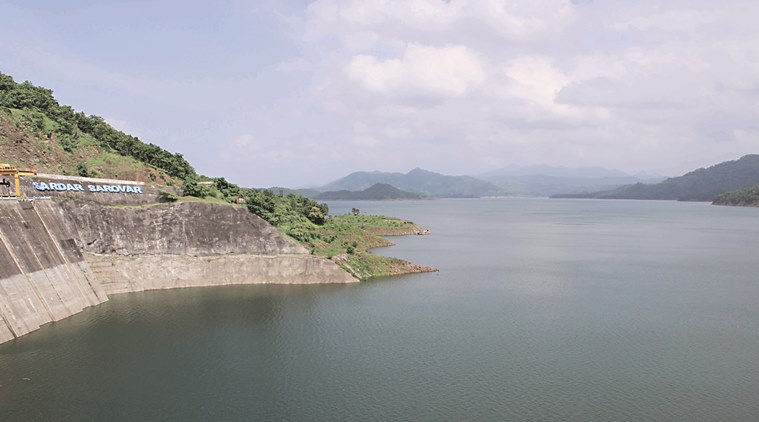- India
- International
Inflow from Madhya Pradesh covers Narmada dam deficit
According to officials, the inflow of water on Tuesday was about 50,000 cusec, of which about 35,000 cusec is due to the release of water from Indirasagar and Omkareshwar dams in Madhya Pradesh that started from August 18.
 Sardar Sarovar reservoir on Tuesday. (Express photo by Javed Raja)
Sardar Sarovar reservoir on Tuesday. (Express photo by Javed Raja)
Heavy rainfall in the catchment areas of Narmada basin and a steady inflow of water from reservoirs in Madhya Pradesh have helped Sardar Sarovar Narmada Dam make up for the water deficit that existed till early August and reach a level of 120.9 metre on Tuesday.
This is just a metre shy of its past maximum reservoir level of 121.9 metre, until the height of the dam was raised to 138.6 metre in September last year.
From 111.3 metre on August 17, with a 0.06 MAF (million acre foot) live storage (72 MCM), the level increased to 120.9 metre by August 28 with a live storage of 1.03 MAF (1,269 MCM). The previous overflow mark of the dam was 121.9 metre.
According to officials, the inflow of water on Tuesday was about 50,000 cusec, of which about 35,000 cusec is due to the release of water from Indirasagar and Omkareshwar dams in Madhya Pradesh that started from August 18.
Within 24 hours on August 18, the Sardar Sarovar dam received over 1.25 lakh cusec, taking the level up by over two metre to 113.57 metre from 111.3 metre on August 17. By August 22, the level increased by another two metre to reach 115.89 metre due to a major inflow from MP, accompanied by heavy rainfall in the catchment areas.

According the Sardar Sarovar Narmada Nigam Limited (SSNNL) officials, the rising water level has put the state in a “comfortable” position as Gujarat is ‘accustomed’ to seeing the water supply of the year through the current level of water.
An SSNNL official said, “On some days in the last week, we had an inflow of up to 1.75 lakh cusec in a single day. Our average inflow since the beginning of this month has been a maximum of about 1.25 lakh cusec per day. Accordingly, the outflow is between 5,000-8,000 cusec from the main canal, after the power generation in the Canal Head Power House (CHPH).”
The authorities, however, are hopeful that the level will rise above 120.9 metre in the remaining monsoon. The state has received 629.6 mm of rainfall so far.
A SSNNL official said, “It appears that we will receive at least as much water as last year for live storage. Last year, against 28 MAF, we got 15.76 MAF live storage after the monsoon. Right now, we have not reached 15.76 MAF but with one month of monsoon still to go, if we have good rain, we will easily have at least the same capacity to see the next summer through. So far, we have got about 12 MAF of water storage.”
Gujarat receives 9 MAF water from the Narmada basin as per the order of the Narmada Tribunal for distribution among four states.
“This distribution is based on the fact that the available storage in the basin should be 28 MAF, out of which 18.25 MAF is for Madhya Pradesh, Gujarat gets 9 MAF while 2.5 MAF is for Rajasthan and 0.25 is for Maharashtra. At any time when the basin has less than 28 MAF, there will be water crisis as none of the dams on Narmada are snow-fed. This distribution equation has 75 per cent reliability, which assures water supply for 75 out of 100 years, based on the study of the rainfall data of the previous century. So, whether we reach the maximum dam storage level or not, it is always necessary to economize the water outflow,” the official said.
The gross storage capacity of the reservoir is about 7.7 Million Acre Feet (MAF) while live storage capacity is 4.75 MAF. The dead storage capacity below minimum draw down level is 2.97 MAF.
Apr 18: Latest News
- 01
- 02
- 03
- 04
- 05






































